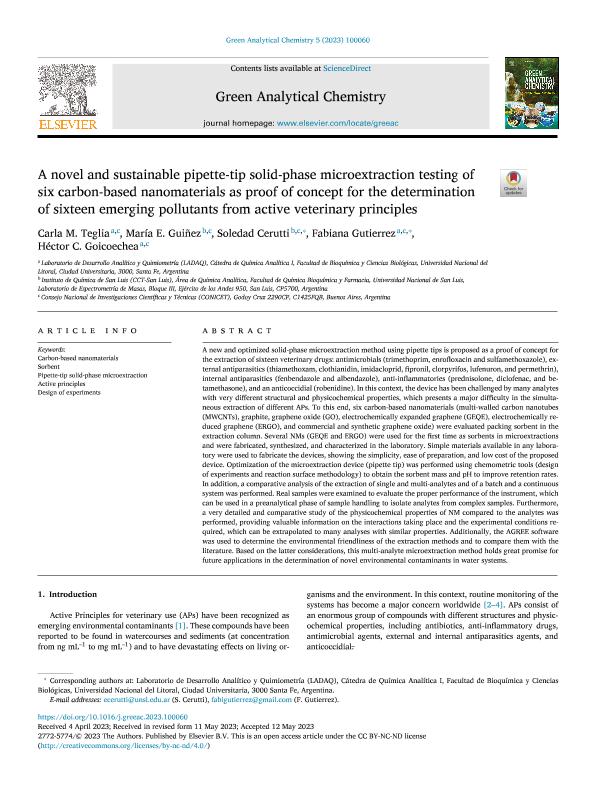Artículo
A novel and sustainable pipette-tip solid-phase microextraction testing of six carbon-based nanomaterials as proof of concept for the determination of sixteen emerging pollutants from active veterinary principles
Teglia, Carla Mariela ; Guiñez, María Evangelina
; Guiñez, María Evangelina ; Cerutti, Estela Soledad
; Cerutti, Estela Soledad ; Gutierrez, Fabiana Andrea
; Gutierrez, Fabiana Andrea ; Goicoechea, Hector Casimiro
; Goicoechea, Hector Casimiro
 ; Guiñez, María Evangelina
; Guiñez, María Evangelina ; Cerutti, Estela Soledad
; Cerutti, Estela Soledad ; Gutierrez, Fabiana Andrea
; Gutierrez, Fabiana Andrea ; Goicoechea, Hector Casimiro
; Goicoechea, Hector Casimiro
Fecha de publicación:
06/2023
Editorial:
Elsevier Science
Revista:
Green Analytical Chemistry
ISSN:
2772-5774
Idioma:
Inglés
Tipo de recurso:
Artículo publicado
Clasificación temática:
Resumen
A new and optimized solid-phase microextraction method using pipette tips is proposed as a proof of concept for the extraction of sixteen veterinary drugs: antimicrobials (trimethoprim, enrofloxacin and sulfamethoxazole), external antiparasitics (thiamethoxam, clothianidin, imidacloprid, fipronil, clorpyrifos, lufenuron, and permethrin), internal antiparasitics (fenbendazole and albendazole), anti-inflammatories (prednisolone, diclofenac, and betamethasone), and an anticoccidial (robenidine). In this context, the device has been challenged by many analytes with very different structural and physicochemical properties, which presents a major difficulty in the simultaneous extraction of different APs. To this end, six carbon-based nanomaterials (multi-walled carbon nanotubes (MWCNTs), graphite, graphene oxide (GO), electrochemically expanded graphene (GEQE), electrochemically reduced graphene (ERGO), and commercial and synthetic graphene oxide) were evaluated packing sorbent in the extraction column. Several NMs (GEQE and ERGO) were used for the first time as sorbents in microextractions and were fabricated, synthesized, and characterized in the laboratory. Simple materials available in any laboratory were used to fabricate the devices, showing the simplicity, ease of preparation, and low cost of the proposed device. Optimization of the microextraction device (pipette tip) was performed using chemometric tools (design of experiments and reaction surface methodology) to obtain the sorbent mass and pH to improve retention rates. In addition, a comparative analysis of the extraction of single and multi-analytes and of a batch and a continuous system was performed. Real samples were examined to evaluate the proper performance of the instrument, which can be used in a preanalytical phase of sample handling to isolate analytes from complex samples. Furthermore, a very detailed and comparative study of the physicochemical properties of NM compared to the analytes was performed, providing valuable information on the interactions taking place and the experimental conditions required, which can be extrapolated to many analyses with similar properties. Additionally, the AGREE software was used to determine the environmental friendliness of the extraction methods and to compare them with the literature. Based on the latter considerations, this multi-analyte microextraction method holds great promise for future applications in the determination of novel environmental contaminants in water systems.
Archivos asociados
Licencia
Identificadores
Colecciones
Articulos(INQUISAL)
Articulos de INST. DE QUIMICA DE SAN LUIS
Articulos de INST. DE QUIMICA DE SAN LUIS
Citación
Teglia, Carla Mariela; Guiñez, María Evangelina; Cerutti, Estela Soledad; Gutierrez, Fabiana Andrea; Goicoechea, Hector Casimiro; A novel and sustainable pipette-tip solid-phase microextraction testing of six carbon-based nanomaterials as proof of concept for the determination of sixteen emerging pollutants from active veterinary principles; Elsevier Science; Green Analytical Chemistry; 5; 100060; 6-2023; 1-11
Compartir
Altmétricas



